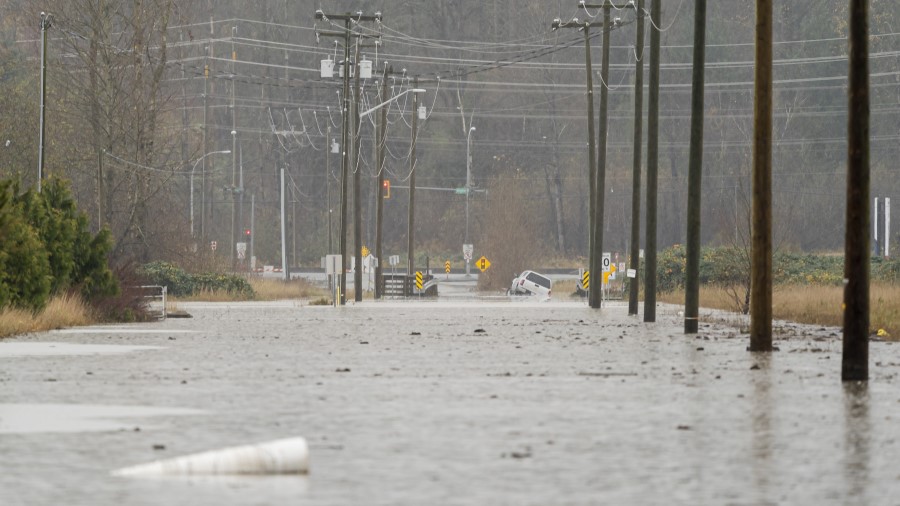Whatcom County mayors send letter asking for drought, flood help
Feb 3, 2022, 5:39 PM | Updated: Feb 4, 2022, 8:44 am

Flood water flows over a road in the Sumas area on Nov. 18, 2021. (Getty Images)
(Getty Images)
A group of Whatcom County mayors sent a letter to the state’s Department of Ecology, Department of Natural Resources, and Department of Agriculture asking for help managing the effects of extreme weather events.
In the letter, the mayors of Ferndale, Blaine, Lynden, Everson, Nooksack, and Sumas described the effects of drought and flooding in their communities — when the Nooksack River has, respectively, either too-high or too-low of water flows.
“The problems that the county is facing are twofold — not enough water in the summer, and too much water in the flood event times, usually in the fall or in the spring,” said Lynden Mayor Scott Korthuis in an interview with ����Xվ Newsradio.
The low flows were especially bad during the hot, dry summer of 2021. The letter states that more than “2,500 much needed salmon died in the South Fork of the Nooksack River alone, and … Fishtrap Creek in Lynden was nothing more than a few ponds connected by a mere trickle of water.”
Washington cherry crop faces challenges of heat wave, wildfires
The low river levels also led to farmers experiencing crop failures — after they had already lost berries and potatoes to the record heat.
“The low instream flows are an issue for the farmers for sufficient irrigation in the summer,” Korthuis explained.
On the other side of the coin, high flows in November meant devastating floods for Whatcom County communities, costing people their homes and livestock. Korthuis noted that more than two months after the floods, 75% of the homes in Sumas — he estimated at least 500 houses — are still unoccupied because of flood damage.
Korthuis and the other mayors are proposing different forms of water storage as a solution — controlling how much water the river receives, and when. As an example, he suggested a managed aquifer recharge project.
“You pull water out of the river in high flow times and you put it into the ground, maybe a quarter-mile or a half-mile away from the river,” Korthuis explained. “And then that water seeps back into the river over time, so it revitalizes the river in the low-flow times.”
Another solution the mayors propose is putting in dams. While some dams in the state have received criticism from environmentalists because of the impediment they present to migrating salmon, Korthuis said dams could be put in areas of the river where salmon do not migrate.
“The North Fork of the Nooksack River has Nooksack Falls — above the falls there are no salmon, because the falls are a significant drop,” Korthuis explained. “So one ideal place to put storage would be upstream on the North Fork of the Nooksack.”
They also suggest adding levees — or widening or raising the current levees — and cleaning sediment off river banks to give the river more capacity and prevent overflow.
“Your attention is all the more urgent because we are informed by experts that climate change is virtually certain to make these twin problems even worse,” the mayors told the departments in the letter.
Korthuis said the Whatcom County mayors do not feel that the bill in the Legislature to add salmon protection buffers on the sides of rivers and streams will help the problem, because it will “take 30,000 productive acres of ag land out of the 60,000 to 70,000 productive acres of ag land.”
The state Department of Ecology says it will be meeting with the mayors next week to discuss solutions.
“We received the letter from the Whatcom County mayors and have reached out to talk with them about their concerns in more detail later this month,” the department said in a statement. “We’re committed to working with all of the communities in the Nooksack River Basin on water supply issues, and finding solutions with our partners to improve flood plain management in the area.”
Follow Nicole Jennings on or email her here.��














